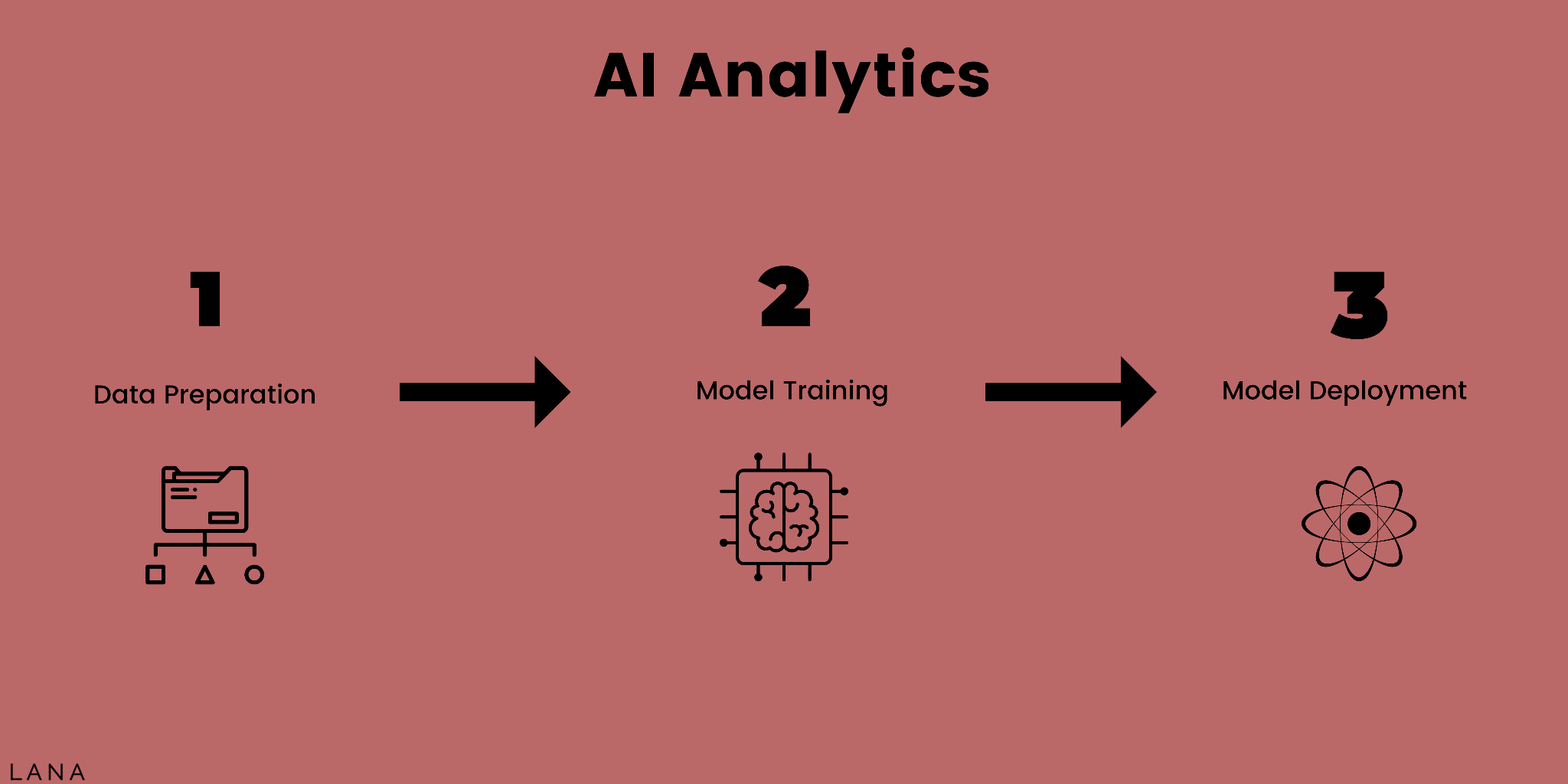Have you ever found yourself wondering, "What is AI Analytics?" If so, don't worry - you aren't alone! It seems like artificial intelligence (AI) and analytics are being used everywhere in the tech world these days. However, for many people, AI analytics remains an enigma. This can be incredibly frustrating. After all, it's hard to get ahead of the curve if you don't understand its terminology!
AI analytics is a term gaining popularity in the world of data science and analytics. Simply put, AI analytics uses machine learning and artificial intelligence algorithms to analyze and interpret complex data sets. With the help of AI, businesses can gain deeper insights into their data, make better decisions, and drive growth.
This article breaks down AI analytics, how it works, and how it can be applied in different industries.
AI Analytics is a powerful tool that leverages machine learning algorithms and artificial intelligence technologies to quickly and easily analyze data to discover valuable insights. Using AI Analytics allows organizations to automate many tedious tasks involved in traditional analytics and gain access to detailed predictions about customer behavior, investment strategies, and more.
Traditional analytics techniques involve using statistical methods to analyze data and generate insights. However, these methods can be time-consuming and require much expertise. AI Analytics automates many of these tasks, making it easier and faster to analyze data and extract insights.
AI Analytics can be applied in various industries, including healthcare, finance, retail, and more. For example, in healthcare, AI Analytics can predict patient outcomes and personalize treatment plans. In finance, it can detect fraud and optimize investment strategies. In retail, it can predict consumer behavior and improve customer experience.
Let's dive deeper into the steps of implementing AI analytics!
The AI Analytics process includes several decisive stages (such as data preparation, model training, and model deployment) to transform raw data into powerful insights that can benefit a company by improving decision-making processes.

The initial stage of the AI Analytics process is data preparation, a critical step in ensuring accurate predictive models. This process involves gathering and cleaning data, selecting relevant features, and converting data into a readily usable format by machine learning algorithms. If you want to maximize the efficiency of your data processing, you may need to use AI technologies (such as Microsoft AI Builder) to extract essential data from PDFs and other document files quickly and accurately.
Data cleaning is an important task that involves removing duplicates, filling in missing values, correcting errors, and ensuring data is consistent and standardized. Feature selection is also a crucial component of data preparation in AI Analytics, as it helps identify the most impactful features likely to influence the predicted outcome. Finally, data conversion is converting data into a format that machine learning algorithms can easily understand and utilize. This often requires numeric or categorical data to ensure it can be easily analyzed and interpreted.
Together, these data preparation steps establish a strong foundation for the AI Analytics process, enabling the machine learning algorithms to make accurate predictions and generate valuable insights for businesses across various industries.
After data preparation, model training is the next essential step in the AI Analytics process. In this step, you select and train the most appropriate machine learning algorithm using your prepared data.
Several types of machine learning algorithms are available for use, including supervised learning, unsupervised learning, and reinforcement learning. Supervised learning involves creating a model via labeled data, where the outcome is already known. In contrast, unsupervised learning consists in training a model on unlabeled data where the objective is to uncover previously unknown patterns. Finally, reinforcement learning differs from the other two, focusing on training a model to learn how to make decisions based on rewards or penalties.
Throughout model training, the algorithm learns to identify patterns within the data and develop predictions accordingly. Then, the model is adjusted based on how accurate its predictions are and retrained until it is considered satisfactory.
Investing time and resources in the AI Analytics process allows businesses to make insightful predictions and recommendations based on large swathes of complex data, providing them with a competitive advantage over competitors.
After model training, the final stage in AI Analytics is model deployment. Then, you deploy the algorithms to a production environment to make predictions based on real-time data.
As you make predictions, you must understand the model may need to be periodically retrained with new data. This maintenance process ensures the algorithm's predictions align with real-world data.
Model maintenance is essential to the AI Analytics process, as data changes over time, and models may become inaccurate if left unattended. Ultimately, the model must provide accurate and actionable insights to help businesses achieve their targets.
AI Analytics is used across various industries and can be applied to different business use cases. Below are some examples of industries that utilize AI Analytics:
AI Analytics can predict patient outcomes and provide personalized treatment plans. For example, AI Analytics can predict the probability of a patient developing a specific disease and suggest preventive measures to reduce the risk.
AI Analytics can help detect fraudulent activities and optimize investment strategies. After analyzing vast amounts of financial data, AI Analytics can detect anomalies in financial transactions and fraudulent activities. Additionally, AI Analytics can predict market trends and optimize investment strategies accordingly.
AI Analytics can be used to predict consumer behavior and enhance customer experience. AI Analytics can analyze customer data, recommend products based on a customer's past purchases, and optimize pricing and inventory management to adhere to consumer preferences.
AI Analytics is a powerful tool for businesses looking to optimize their marketing efforts. Leveraging AI technology allows businesses to identify customer behavior and preferences, predict which customers are more likely to respond to campaigns, and personalize campaigns based on those insights.
AI analytics can also improve the efficacy of your content creation process by utilizing AI copywriting tools, which will help you create blog posts tailored to your target audience in less time.
AI Analytics can optimize production processes and minimize waste. Use AI Analytics to predict when a machine is likely to fail. This way, the time and resources allocated for maintenance can be optimized, reducing downtime and waste.
The versatility of AI Analytics enables businesses to leverage data to make informed decisions and enhance their operational efficiency.
AI Analytics presents a few challenges that must be considered when utilizing the technology.
The first challenge is the need for large, high-quality datasets to train machine learning algorithms effectively. Access to sufficiently large datasets is necessary to achieve accurate predictions and insights. Additionally, data quality significantly impacts the predictions' accuracy, making data quality an essential factor when working with AI Analytics.
The second challenge is associated with expertise in data science and machine learning. While AI Analytics may require a high degree of technical knowledge, many organizations may need more resources to hire a team of data scientists. In addition, organizations that don't have access to individuals with expertise in data science and machine learning may need help to leverage the technology effectively.
Finally, there are ethical considerations associated with the use of AI Analytics. This technology can make decisions that significantly impact people's lives (such as healthcare treatment plans or credit decisions). Systematically ensuring these decisions are fair, transparent, and unbiased is essential for organizations seeking to utilize this powerful tool responsibly.
AI Analytics is a powerful tool that can be used to gain deeper insights into data, make better decisions, and drive growth. It uses machine learning algorithms and artificial intelligence technologies to analyze and interpret complex data sets.
While AI Analytics has many benefits, it also presents challenges, including the need for large, high-quality data sets, expertise in data science and machine learning, and ethical considerations. If you want to meet these challenges and maximize your success with AI Analytics, consider leveraging the tools available from Alibaba Cloud. Businesses can take advantage of the Alibaba Cloud Infrastructure Support Plan to store their data assets securely while gaining access to leading-edge AI analytics capabilities.

Alanna Gerton is a content writer and the founder of LANA, a platform dedicated to empowering others to discover their full potential through trendy technology and fostering personal growth.
Free feel to contact her via:
Email: lana@lanagerton.com
Alibaba Clouder - March 22, 2021
Alex - June 18, 2020
Alibaba Clouder - June 22, 2020
Alibaba Clouder - February 2, 2021
Alibaba Clouder - May 24, 2021
Alibaba Cloud Community - December 27, 2021
 AI Acceleration Solution
AI Acceleration Solution
Accelerate AI-driven business and AI model training and inference with Alibaba Cloud GPU technology
Learn More Tongyi Qianwen (Qwen)
Tongyi Qianwen (Qwen)
Top-performance foundation models from Alibaba Cloud
Learn More Alibaba Cloud for Generative AI
Alibaba Cloud for Generative AI
Accelerate innovation with generative AI to create new business success
Learn More Platform For AI
Platform For AI
A platform that provides enterprise-level data modeling services based on machine learning algorithms to quickly meet your needs for data-driven operations.
Learn More